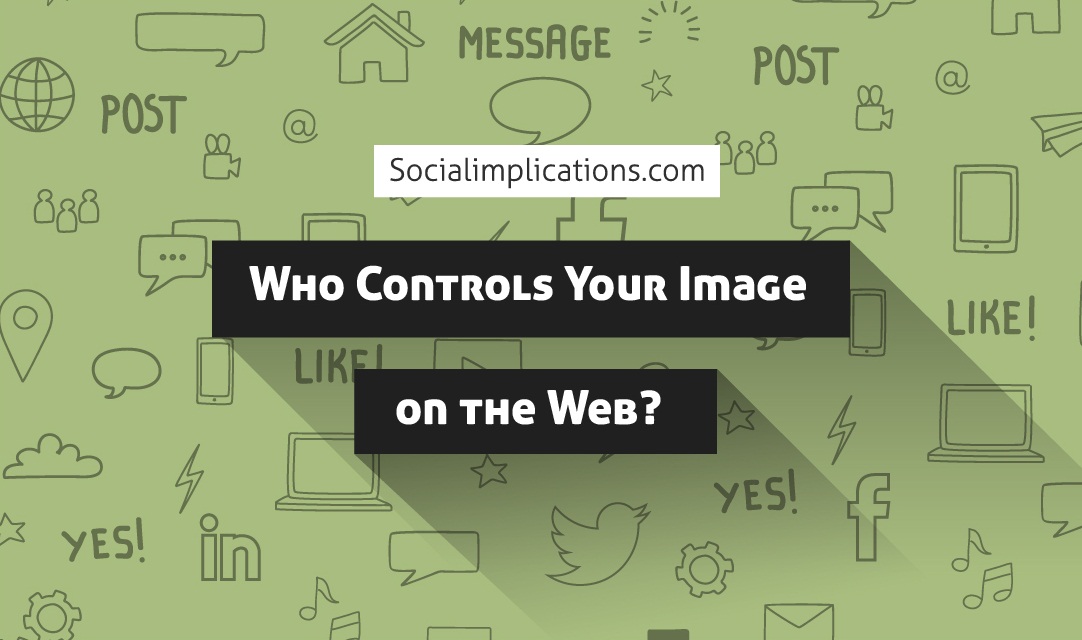
Uh oh. I used that little taboo term in social media, didn’t I? “Control.” Companies want some level of control but customers don’t want to be controlled. That’s understandable. What leaves me scratching my head though is when I see so-called social media experts telling business owners and executives that they should just let it go — that their customers control their image online now. So. Not. True.
Here’s a dose of a reality for you (because who couldn’t use a wee bit of that?). YOU control your image online. YOU control your image across the social media landscape. The only way others control your, or your company’s, image online is if you become complacent and just sit back and let them. You’re not that foolish though, are you?
How Important is it to Control Your Image Online?
It doesn’t really matter if we’re talking about online or off. Your image is important. Your company’s image is important. It’s how your audience or market sees you. It determines what they think of you. It influences their trust in your company. It sways purchase decisions. Yes. Your image is important.

You can’t afford to trust that image development or management to the social mob. You can’t build a marketing plan around what they may or may not say or do. You can’t set goals or focus on your company’s mission when you’re always worried about the “what if.” What if people post negative reviews on social networks? What if people don’t blog about us favorably? What if? What if? What if? … Who cares?
Okay, okay. You should care. I’ll give you that. But you shouldn’t mistake the ability to participate in conversations for control over your company’s image. Think of it this way — all of your customers, readers, or whoever your target audience consists of are like this big conversational sea. It might be calm one day and you might hit rough waters the next. But either way, you’re always at the helm. You have the ability to steer or influence the image your company portrays.
How Can You Control Your Image on the Web?
When I’m talking about “control” here, I’m not talking about our big bad buddy, Mr. Manipulation. I don’t advocate using social media tools and strategies to try to portray a false image of who you are or what your company is all about. I’m talking about good old fashioned PR — managing relationships with your various audiences and doing the “right” thing.

Controlling your image online involves offering quality products or services (or whatever it is that you offer), being responsive to audience needs, and being as open as you can reasonably be with your audience (giving away trade secrets is taking it just a bit too far on the transparency front I’d say).
Those are some of the basic elements of controlling your image on the Web. Here are some more specific ways you can incorporate social media tools into your supposedly dastardly little image-control campaign.
- Start conversations — Don’t wait around for customers or others to start talking about you or your products. Start those conversations yourself. Sure, you could run polls on your website or social networking profile pages, but why not make it a real conversation? Turn to the company blog to solicit more qualitative feedback instead through reader comments. Don’t just get a general idea of what they like and don’t like. See what people really think. You can’t improve your image (or work to maintain a positive image) if you don’t know what your audience thinks of you to begin with.
- Respond — It’s not enough to post to your blog, a social network, a microblog, etc. asking for feedback. You need to actually read that feedback and, more importantly, you should try to respond. No one’s saying you have to respond to everything people say (or if they do they’re bloody insane so just gently nod and walk away). Try to at least address points you see on a consistent basis. If a lot of your customers are saying the same thing, that’s something you might want to respond to. Showing that you’re paying attention to your customers can go a long way towards building a positive image online.
- Don’t act impulsively — As you’re engaging in a two-way conversation with your customers or other audiences via social media, you are more than likely going to come across negative feedback. Don’t fly off the handle telling that little schmuck what you really think of him. Should you respond quickly? Yes. The social Web won’t stop and wait while you catch up. But think first. Is there any validity in those negative comments? Is there a way to address them that makes you look good? (Maybe acknowledge a point and ask what they would suggest to fix it so you can show genuine interest.) Or is it one of those “you don’t have to respond to everything” moments? Sometimes it is.
The social media boom doesn’t mean you have to worry that your company’s image is completely out of your control. It just means making an honest effort to do your best, engage your audience, and keep your customers happy is important. And really, hasn’t that always been key to controlling your company’s image? Social media might shake things up a bit, but in the end good business fundamentals still win out.














Knowing what your customers say is vital and giving thanks to those who like your product/services as well as listening to those unsatisfied is very important. More and more people are using the social networks now to look for info, and if you can place only nice testimonials on your websites, most likely you will find some not that good on facebook or twitter. It’s important to respond, to give attention to every “bad” comment and try making things better. Even if you don’t have the solution ready at the moment you do show that you are a customer oriented company, don’t loose this opportunity.
I spend years in the traditional customer service world and managing your image online still comes down to a basic, fundamental commitment to your customers – no matter who they are. The Internet has simply given us an unprecedented opportunity to do that, as well as providing evidence of that commitment to hundreds, thousands, even millions of people who may tangentially witness our interactions with current or prospective customers.
Let’s face it, sometimes things aren’t going to go exactly as planned. How we respond to those less than optimal situations is really where the rubber meets the road when it comes to customer service. It’s easy to talk about how great we are when the seas are smooth. Statistics show that customer loyalty from those who have had a bad experience resolved swiftly and well is considerably higher than the customer loyalty of those who have never had an issue at all.
We must learn to use those opportunities to show the world what a company is truly made of…that not only are you committed to doing everything possible to make sure things don’t go wrong, but that when things do we will do everything within our power to make it right. The Internet gives us the opportunity to illustrate that commitment like never before. Not taking advantage of it is a huge mistake. The companies that recognize the opportunity will be the ones who come out of this economic downturn with an ace in the hole, while the rest – if not already bankrupt – will find themselves behind the proverbial 8 ball.
Yup … it’s about being clear about what you control [your vision and service offerings and the values that underpin your work practice] … and what you don’t [how people react to your organisation and their offerings].
Working with non profits in Ireland my sense is that BSM [before social media] the scale and scope and immediacy of service user [and other stakeholders] feedback was limited and time delayed. Now? SM … with it’s capacity for instant, broad and diverse feedback is really challenging for organisations and makes them feel they have lost control.
They may have lost the illusion of control in terms of user feedback [which they never had any real control over anyway… SM has just shown the naked emperor] … but they still have clear control and influence and authority over the core of their business.
SM just provides a very immediate way of gaining user feedback and engaging people in the vision and actions of the organisation.
You know, even if a company gets bad comments online they can turn it around if they know how to act right. Talk about the problems your customers have–show that you are open, involved and care and it will do a lot more for your reputation than a generic online presence that tries to deflect every criticism.
Anastasia — Actually that’s a common mistake. No, people shouldn’t feel like they have to respond to every negative comment. What’s important is addressing valid negative feedback (meaning something constructive and not solely a case of someone trying to piss on your parade), and especially addressing widespread criticisms (if many people are saying the same thing, it’s probably something you want to look into). If you try to respond to everyone, you’ll never have the time to truly address the problems that matter. Remember, not all negative feedback comes from customers. Sometimes it’s from the competition or simply people who disagree with your company stance on an issue (and I doubt there’s any issue where 100% of folks in the market are going to agree completely). You can’t always make everyone happy, and trying to will just get in the way of real progress.
Alysson — You’re right. Bad things will happen. No amount of planning can guarantee otherwise. But the companies who are prepared to handle problems effectively as they arise are the ones that consumers are likely going to remember positively.
Liz — Social media is absolutely an area that allows for more immediate customer feedback. Unfortunately we’re still at a time where it’s so new to many companies that they either neglect it or they over-do it (trying to be everywhere rather than targeting strategies and tools that would most effectively help them communicate with their own audience).
Yo — You know I agree with you on that one. We both can think of a certain company whose paid mouthpiece likes to incite mob response to try to silence anyone who criticizes them. It’s sad. More interesting is the fact that said company is apparently so interested in the image they portray, yet they allow it to continue. Eventually people do start to notice when you try to shut up your naysayers without ever addressing the issues, and it doesn’t do anything to help the already negative image you have. You don’t fix image issues by simply trying to change what people call you or unleashing the dogs.
[…] Who Controls Your Image On the Web – This is my favorite excerpt: […]